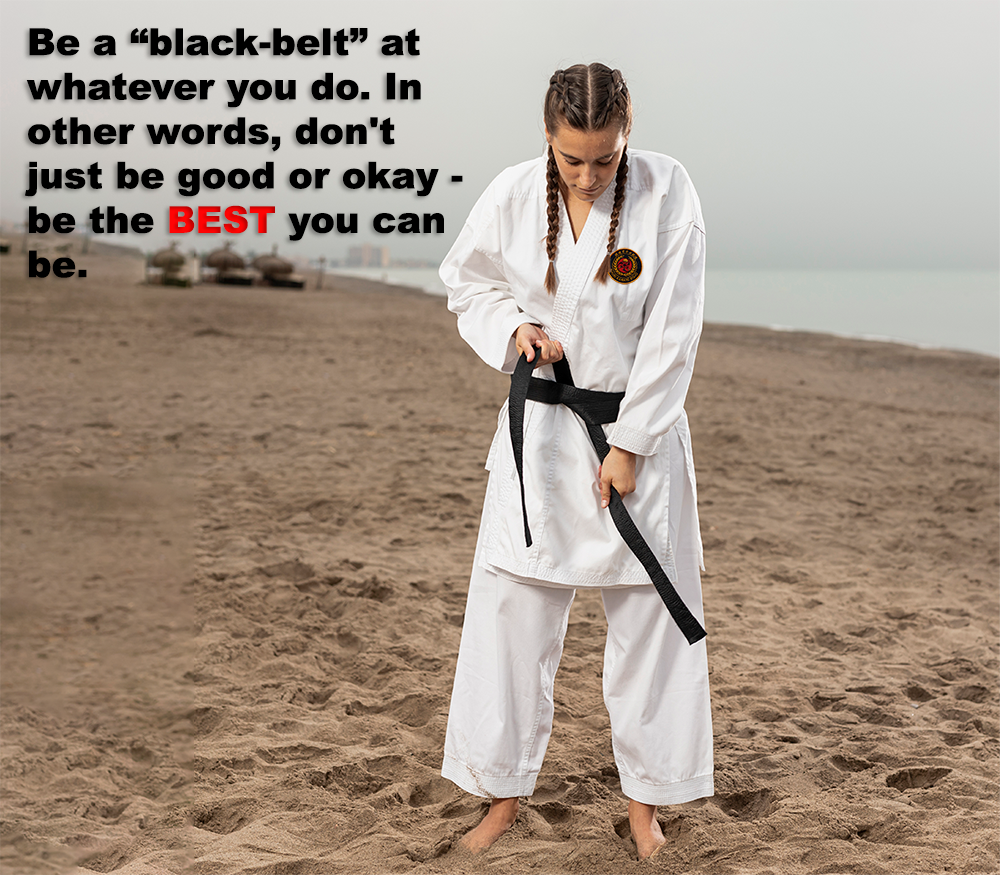
Be a “black-belt” at whatever you do. In other words, don’t just be good or okay – be the BEST you can be.
Posted by ADAM CARTER on NOV 28, 2022

Be a “black-belt” at whatever you do. In other words, don’t just be good or okay – be the BEST you can be.
Teachers teach content then test students. This cycle of teaching and testing is familiar to anyone who has been a martial arts student. Tests seek to see what students have learned.
Tests are supposed to be evaluations that see what you know at a particular point in time. But teaching students to practice for 'tests’ in every lesson, shifts the focus away from knowledge.
For some schools promoting people to black-belt is nothing more than a money making and ego boosting enterprise (I have promoted “X” number of black-belts). There is no doubt that belts can be a money-making scheme for some.
Instructors create tests to measure their students' understanding of specific content, or the effective application of critical thinking skills. Such tests are used to evaluate student learning, skill level, and growth.
But teaching students content, just to pass the next grade, at every lesson, telling students what they need to know, students will then simply commit this to memory, by rote. Simply learning the curriculum at a basic level, leaves little time for students to acquire a deeper understanding of the subject, or to develop life-long skills, such as critical thinking and problem solving.
Learning is not committing a set of facts to memory, but the ability to use, evaluate and apply the skills they have been taught.
There should be two categories of testing: formative and summative.
Formative assessment, is the name given to the steady little nudges that happen throughout every training session - when the instructor calls on a student, to solve a problem or answer a question.
What distinguishes formative assessments is that they're not there to judge a student as a success or failure. The primary purpose is to guide both student and teacher.
Summative assessment, on the other hand, sums up all your learning on one big day: the grading or promotion test, the final exam.
Learning and teaching in the martial arts is much the same as in other endeavors. Someone will do a lot of teaching, but you have to do a lot of learning. The point is, it is up to you.
The thing to keep in mind, though, is that a grade or rank is a status within an organization, and the organization bestows it. There are practitioners of the same grade with some questionable technical competence, and others who are exceptional.
Rank and belts are not equivalent between arts, styles, or even within some organizations. In some arts, a black-belt may be awarded in three years or even less, while in others it takes dedicated training of ten years or more.
Belts and grades are a very useful tool when correctly employed. They can provide structure to a training program by requiring that competence, a real understanding (not just tokenism), is shown before new material is introduced. In that regard, it’s no different to any other form of education. They are just internal markers within groups though and there can be no meaningful comparisons across groups, and this has nothing to do with the style of martial art you practice, before you say yours is the best.
Grades are internal markers only, and I have learnt not to make any assumptions based on them. You’d think any person ranked 3rd dan would be skilled and knowledgeable, but I have seen some 3rd dans that I’d personally rank at around 5th kyu, with these “instructors” didn’t have the first clue about body mechanics, principles or tactics.
The martial arts are not simply concerned with achieving the next belt. You need to make consistent and regular efforts over a long period of time, to gain knowledge, a deeper understanding, to develop life-long skills, and not just “cover the content”.
![]() Photo Credit: Freepik
Photo Credit: Freepik
